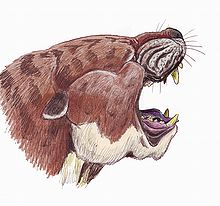Creodonta
Primitive carnivores, pseudopredators, or creodonts (Creodonta) are a now-defunct taxon that originally referred to a group of extinct carnivorous mammals. The taxon was described by Edward Drinker Cope in 1877, and by well into the 20th century more than 45 genera had been described. Creodonta were considered the predominant predatory mammals in the Paleogene. Although they resembled modern dogs, cats, bears, hyenas, or mongooses, they are not closely related to present-day carnivores (Carnivora). Within Creodonta, two families were distinguished, the dog- or hyena-like Hyaenodontidae, of which Hyaenodon was the best known representative, and the more cat-like Oxyaenidae. A distinctive feature of the Creodonta was the crushing scissors, which sat further back in the mouth (Hyaenodontidae: between the second molars in the upper jaw and the third molar in the lower jaw; Oxyaenidae: between the first molar in the upper jaw and the second molar in the lower jaw) than in today's carnivores (fourth premolar in the upper jaw; first molar in the lower jaw).
The Creodonta lived in Europe, Asia, North America and Africa. In Eurasia and North America, all Creodonta died out at the end of the Oligocene, only in Africa some genera managed to survive into the Miocene. However, the genus Hyainailouros managed to recolonize Eurasia from Africa in the Miocene and to delay the extinction of the creodonts here as well. In the later Miocene, however, all creodonts had also disappeared in the Old World.
Already in the early 1970s, Leigh Van Valen doubted that the Creodonta formed a common group. The doubts were later taken up by some palaeontologists such as Michael Morlo from the Senckenberg Research Institute or the Belgian researcher Floréal Solé. According to them, there are no clear synapomorphies - common, newly acquired features - between the two families of Hyaenodontidae and Oxyaenidae, which means that a taxon Creodonta, as still accepted in the list of McKenna and Bell 1997, would not exist; the use of the term is mostly just out of habit. In the case of common features existing between the Carnivora and the two families of Creodonta, such as in the formation of the crushing scissors or characteristics at the base of the skull or in the structure of the foot, respectively, it is unclear whether these are synapomorphic or possibly just convergently acquired traits. Solé therefore proposed in 2013 that the two families of Creodonta should each be elevated to an order rank. Based on this, three evolutionary lineages are to be distinguished within the carnivore-like higher mammals (excluding Mesonychia as an ungulate-like group): the Carnivoramorpha (including the Carnivora and the extinct Viverravidae and Miacidae), and the Hyaenodonta (also Hyaenodontida) and the Oxyaenodonta (also Oxyaenida). Partially, the Proviverroidea was assumed to be another group for which a closer relationship with the Cimolesta was debated. Subsequently, the division of the Creodonta according to Solé 2013 into the following two orders prevailed:

Head reconstruction of Sarcastodon (Oxyaenodonta, Late Eocene of Mongolia)
Questions and Answers
Q: What is the traditional classification of Creodonta?
A: Traditionally, Creodonta are classified as an extinct order of mammals which lived from the Palaeocene to the Miocene epoch.
Q: How do modern carnivores and creodonts differ in terms of their teeth?
A: The carnassial teeth of modern carnivores and both groups of creodonts are not formed from the same teeth, suggesting that creodonts are not the ancestors of modern carnivores.
Q: When did Creodonta become dominant in ecosystems?
A: Creodonta became dominant in ecosystems from 55 to 35 million years ago (mya).
Q: Who competed with Creodonta for dominance?
A: Creodonta competed with Mesonychids and Entelodonts for dominance.
Q: What caused them to eventually lose ground to Carnivora?
A: Ultimately, they lost ground to Carnivora due to competition for resources.
Q: When were the first creodont fossils discovered?
A: The first creodont fossils were discovered in the Palaeocene, about 60 million years ago (mya).
Q: When did Dissopsalis go extinct?
A: The last genus of creodon went extinct eight million years ago.
Search within the encyclopedia